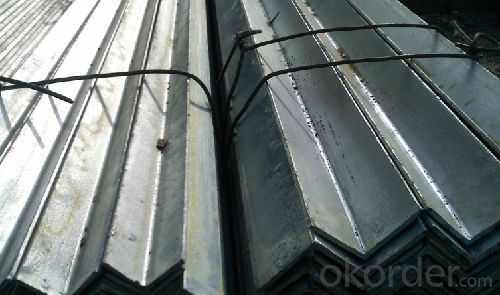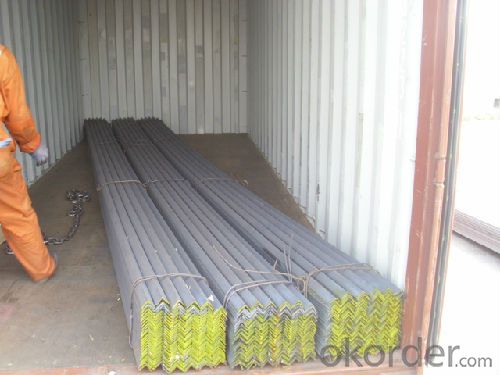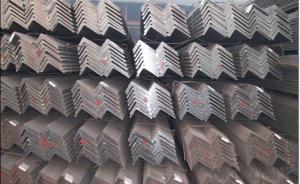Unequal Angle Steel HR Q235-420Series, SS400-540Series, S235JR-S355JR, A36-A992
- Loading Port:
- Tianjin
- Payment Terms:
- TT or LC
- Min Order Qty:
- 30 m.t.
- Supply Capability:
- 38000 m.t./month
OKorder Service Pledge
OKorder Financial Service
You Might Also Like
Product Description:
OKorder is offeringUnequal Angle Steel HR Q235-420Series, SS400-540Series, S235JR-S355JR, A36-A992at great prices with worldwide shipping. Our supplier is a world-class manufacturer of steel, with our products utilized the world over. OKorder annually supplies products to European, North American and Asian markets. We provide quotations within 24 hours of receiving an inquiry and guarantee competitive prices.
Product Applications:
Unequal Angle Steel HR Q235-420Series, SS400-540Series, S235JR-S355JR, A36-A992 are ideal for structural applications and are widely used in the construction of buildings and bridges, and the manufacturing, petrochemical, and transportation industries.
Product Advantages:
OKorder'sUnequal Angle Steel HR Q235-420Series, SS400-540Series, S235JR-S355JR, A36-A992are durable, strong, and resist corrosion.
Main Product Features:
· Premium quality
· Prompt delivery & seaworthy packing (30 days after receiving deposit)
· Corrosion resistance
· Can be recycled and reused
· Mill test certification
· Professional Service
· Competitive pricing
Packaging & Delivery:
Packaging Detail: products are packed in bundle and then shipped by container or bulk vessel, deformed bar is usually naked strapping delivery, when storing, please pay attention to moisture proof. The performance of rust will produce adverse effect.
Each bundle weight: 2-3MT, or as required
Payment term: TT or L/C
Delivery Detail: within 45 days after received advanced payment or LC.
Label: to be specified by customer, generally, each bundle has 1-2 labels
Trade terms: FOB, CFR, CIF
FAQ:
Q1: Why buy Materials & Equipment from OKorder.com?
A1: All products offered byOKorder.com are carefully selected from China's most reliable manufacturing enterprises. Through its ISO certifications, OKorder.com adheres to the highest standards and a commitment to supply chain safety and customer satisfaction.
Q2: How do we guarantee the quality of our products?
A2: We have established an advanced quality management system which conducts strict quality tests at every step, from raw materials to the final product. At the same time, we provide extensive follow-up service assurances as required.
Q3: How soon can we receive the product after purchase?
A3: Within three days of placing an order, we will begin production. The specific shipping date is dependent upon international and government factors, but is typically 7 to 10 workdays.
Images:


- Q:What are the common connection methods for steel angles?
- The common connection methods for steel angles include bolting, welding, and using mechanical fasteners such as screws or rivets. These methods ensure a secure and stable connection between steel angles, allowing them to be used effectively in various structural applications.
- Q:What are the common installation methods for steel angles?
- The common installation methods for steel angles include welding, bolting, and using adhesive.
- Q:Can steel angles be used as supports for overhead doors or garage doors?
- Yes, steel angles can be used as supports for overhead doors or garage doors. Steel angles provide structural stability and strength, making them suitable for supporting the weight of these doors. Additionally, steel angles are resistant to corrosion and can withstand heavy loads, making them a reliable choice for this purpose.
- Q:Can steel angles be used in earthquake-resistant building designs?
- Indeed, earthquake-resistant building designs can incorporate the usage of steel angles. Steel, renowned for its exceptional strength and ductility, proves to be a suitable material for constructing earthquake-resistant structures. In various applications, steel angles, also referred to as L-shaped steel sections, can be employed to provide structural support and reinforcement. One of the primary benefits of incorporating steel angles into earthquake-resistant building designs lies in their capacity to withstand lateral loads and shear forces. The L-shape of these steel angles establishes a robust and stable connection between distinct structural components, effectively distributing and transferring loads during seismic events. Consequently, this aids in mitigating structural deformation and averting collapse. Additionally, the fabrication and installation of steel angles are exceptionally convenient, rendering them a favorable choice for earthquake-resistant designs. These angles can be welded, bolted, or riveted to other steel elements, ensuring a sturdy and dependable connection. Furthermore, customization options are available, allowing for structural configurations to be tailored to meet specific design requirements. Furthermore, steel angles exhibit commendable fire resistance properties, a crucial aspect to consider in earthquake-resistant designs. Compared to other building materials, steel retains its structural integrity for an extended period in the event of a fire, thereby reducing the risk of collapse during rescue operations. To conclude, it is evident that steel angles can indeed be utilized in earthquake-resistant building designs. Their exceptional strength, ductility, and capability to withstand lateral loads make them an invaluable component in structural systems. By implementing appropriate design and installation techniques, steel angles can enhance the overall resilience and safety of buildings situated in earthquake-prone areas.
- Q:Can steel angles be used in telecommunications or broadcasting structures?
- Absolutely! Steel angles have a multitude of applications in the telecommunications and broadcasting industry. Their exceptional strength, durability, and versatility make them a staple in construction. From antenna mounts to equipment racks and cable trays, steel angles offer unparalleled structural support and stability. Moreover, their effortless fabrication and ability to be tailored to meet precise design specifications further solidify their suitability for a vast array of telecommunications and broadcasting needs.
- Q:Are steel angles prone to rust or corrosion?
- Yes, steel angles are prone to rust or corrosion. Steel, when exposed to oxygen and moisture, can undergo a chemical reaction called oxidation, resulting in the formation of iron oxide, commonly known as rust. This process can weaken the structural integrity of the steel angles over time. To prevent or minimize rust or corrosion, steel angles are often coated with protective layers, such as paint, galvanization, or other anti-corrosion treatments. Regular maintenance and inspection are also crucial to identify and address any signs of rust or corrosion early on to prolong the longevity and performance of steel angles.
- Q:Can steel angles be used for sign supports?
- Yes, steel angles can be used for sign supports. Steel angles provide strength and stability, making them suitable for supporting signs of various sizes and weights. They are commonly used in the construction industry for a variety of structural applications, including sign supports. The angles can be easily welded or bolted together to create a sturdy framework for the signs. Additionally, steel angles are durable and resistant to environmental factors such as wind, rain, and corrosion, ensuring the longevity of the sign supports.
- Q:What are the different types of steel angles used in bridge construction?
- Bridge construction commonly utilizes various types of steel angles that serve vital roles in providing structural support and stability to the bridge. 1. Equal Leg Angles, also referred to as L-shaped angles, possess two legs of equal length forming a 90-degree angle. These angles support and reinforce the bridge components during construction. 2. Unequal Leg Angles, as implied, have two legs of different lengths forming a 90-degree angle. These angles are frequently employed in bridge construction to accommodate specific design requirements and support varying loads. 3. Bulb Angles are unique angles characterized by a bulb-shaped leg. They enhance the strength and rigidity of the bridge structure, particularly in areas expected to experience high stress or heavy loads. 4. Inverted Angles are similar to equal leg angles, but their orientation is inverted, with the longer leg positioned at the bottom. These angles provide additional support and stability, especially when the bridge must withstand lateral forces. 5. Fillet Welded Angles are angles joined together using fillet welds. Their purpose in bridge construction is to establish robust and durable connections between different bridge components, ensuring structural integrity and stability. Each steel angle type possesses distinct properties and advantages, rendering them suitable for specific applications in bridge construction. The selection of the appropriate angle type depends on factors such as load requirements, span length, design specifications, and structural considerations. Professional engineers and designers diligently evaluate these factors to determine the most suitable steel angle for a given bridge construction project.
- Q:How do you calculate the effective length of a steel angle?
- To calculate the effective length of a steel angle, you need to consider its end conditions and support conditions. It is determined by analyzing the buckling behavior and stability of the angle under different loading conditions. This involves considering factors such as fixed or pinned ends, bracing conditions, and the angle's geometric properties. By applying relevant formulas or structural analysis methods, you can determine the effective length and use it to assess the angle's structural stability and design requirements.
- Q:What is the maximum temperature that steel angles can withstand?
- The grade of steel utilized determines the maximum temperature that steel angles can tolerate. Typically, low carbon steel angles can endure temperatures of 600-700 degrees Celsius (1112-1292 degrees Fahrenheit) before their mechanical attributes start to decline. Nevertheless, higher carbon steels, stainless steels, or alloy steels have the capacity to withstand elevated temperatures, which may range from 800-1200 degrees Celsius (1472-2192 degrees Fahrenheit) or possibly even higher. It is crucial to refer to the specific material specifications or seek guidance from a materials engineer to ascertain the maximum temperature that a specific steel angle can withstand in a given application.
1. Manufacturer Overview |
|
|---|---|
| Location | |
| Year Established | |
| Annual Output Value | |
| Main Markets | |
| Company Certifications | |
2. Manufacturer Certificates |
|
|---|---|
| a) Certification Name | |
| Range | |
| Reference | |
| Validity Period | |
3. Manufacturer Capability |
|
|---|---|
| a)Trade Capacity | |
| Nearest Port | |
| Export Percentage | |
| No.of Employees in Trade Department | |
| Language Spoken: | |
| b)Factory Information | |
| Factory Size: | |
| No. of Production Lines | |
| Contract Manufacturing | |
| Product Price Range | |
Send your message to us
Unequal Angle Steel HR Q235-420Series, SS400-540Series, S235JR-S355JR, A36-A992
- Loading Port:
- Tianjin
- Payment Terms:
- TT or LC
- Min Order Qty:
- 30 m.t.
- Supply Capability:
- 38000 m.t./month
OKorder Service Pledge
OKorder Financial Service
Similar products
New products
Hot products
Related keywords



























